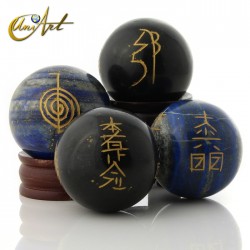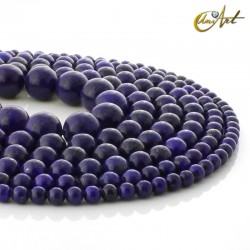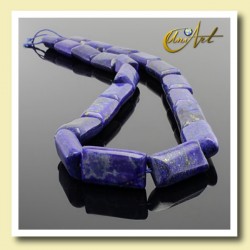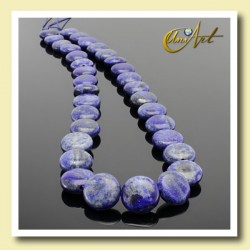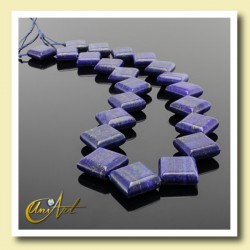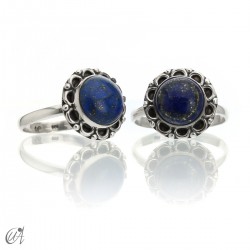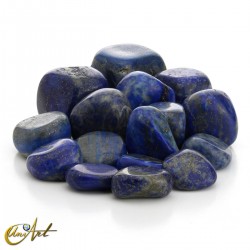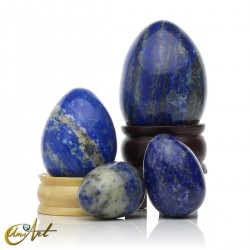Introduction: What is lapis lazuli?
Lapis lazuli is a stone that stands out for its ultramarine blue color (indigo). Actually, this mineral is a composition of lazulite, pyrite and calcite, thus belonging to the group of silicates along with sodalite.
Its formation is due to a metamorphic transformation. That is, it is formed due to the subjection by the Earth itself to high pressures and temperatures. In short, it is a metamorphic rock.
Regarding the Mohs Hardness Scale, lapis lazuli is around 5.5. That is, it has the same hardness as a knife or a glass plate. To situate ourselves in this context, we remember that the diamond has a 10 on the scale and a human fingernail, a 2.5.
The word “lapis lazuli” is a word made up of two lexemes of cult origin: “lapis” and “lazhward”. Both words, coming from Latin and Persian respectively, mean "blue stone" thus referring to its color that ranges between deep blue and violet.
History and legends of lapis lazuli
In ancient times it was a symbol of royalty because it was very expensive and difficult to find.
Lapis lazuli has been mined since ancient times. The first known use of lapis lazuli dates back to 6000 BC. C. in Mesopotamia, in the region that is now Afghanistan, and was later traded to other parts of the world.
Uses of lapis lazuli in history
It was used as a pigment in ancient Egyptian paintings, mosaics and sculptures where it was also used as eyeshadow or eyeliner.
In addition, for the ancient Egyptians, lapis lazuli was of great importance in the field of goldsmithing and has long been used as a gem adorning a wide range of jewels and objects, many of them preserved to this day in the Pharaonic treasures. .
One of the most iconic pieces of Egyptian art is undoubtedly the funerary mask of Pharaoh Tutankhamun, where the various lapis lazuli stones used stand out among other gems. In ancient Rome, it was ground into a powder and then applied to the skin as an anti-aging agent. They also used it as a symbol of wealth and power.
Medieval Christians used lapis lazuli to symbolize truth, faith, and purity. In medieval times it was believed to be an amulet against curses and to ward off disease.
The ultramarine blue pigment was produced in the Middle Ages by grinding lapis lazuli and using it for paint. It became popular with painters and was used by many well-known artists, especially during the Renaissance in Europe, due to its color stability and durability.
Renaissance artists, including Leonardo da Vinci, used it extensively causing its price (at the time) to be four times the price of gold. This is why lapis lazuli powder was known as blue gold.
Lapis lazuli in Hinduism
In Hinduism, the stone is associated with Shiva and Vishnu. It is a symbol of balance and universal truth. It is also said to symbolize the meeting point of the earth and the sky, the two worlds that coexist in harmony. Blue is a color that is often associated with spiritual qualities such as peace, calm, faithfulness, honesty, and clarity. In ancient India, the lapis lazuli stone was used in rituals and jewelry to represent the sky.
Where does Lapis Lazuli come from?
The largest reserves of lapis lazuli on the planet are located in Afghanistan, where the best and most precious lapis lazuli in the world are extracted.
Chile also stands out in the production of lapis lazuli, although the quality of its stones is different.
Qualities of lapis lazuli
The quality of lapis lazuli can be determined by its color. The more vibrant and intense the color, the higher quality it will be.
As a characteristic feature of lapis lazuli, we observe that it has traces of pyrite and sodalite on its surface. These imperfections do not detract from the quality of the mineral but on the contrary, they enhance it.
The most prized lapis lazuli stones have a deep blue color with golden flecks of pyrite in them.
In commercial jewelry you can find natural lapis lazuli stones with a color reinforcement. This process of dyeing the stone makes the white spots disappear from the surface, leaving the most intense blue color.
Properties and esoteric characteristics of Lapis Lazuli
Lapis lazuli is not only associated with the third eye but with all the chakras. It has been said to help balance your energies and bring peace to your life. It is also believed to provide insight into one's future, as well as increase psychic abilities. In the horoscope, lapis lazuli corresponds to Sagittarius and Pisces.
It is considered the stone of heaven.
Original lapis lazuli vs fake lapis lazuli
Unfortunately, there are replicas of lapis lazuli on the market. That is, products that are sold as natural lapis lazuli are actually fake. How then can we differentiate between a true lapis lazuli and a false one?
The most common way to tell the difference between the two stones is by looking at the inclusions. True lapis lazuli will have pyrite or calcite inclusions, while replicas will not have these inclusions. The color of real lapis lazuli can vary in tone in the same stone and its inclusions do not have a defined pattern, the fake one is usually of a uniform color. Natural lapis lazuli can never be translucent and/or transparent, it is always opaque.
Fake lapis lazuli comes from an imitation process in which it is made from dyed marble or limestone, while real lapis lazuli comes from deposits found in Afghanistan, Chile, India, and Russia.
Other imitations are made with synthetic plastics. These copies are usually not very similar to the original lapis lazuli and we can distinguish them by their temperature. Plastic is usually at room temperature while a natural mineral will be cold. Also, if we try to hit it against the teeth, the plastic imitation will produce a dull sound.
Unfortunately, these replicas abound in the market and every day counterfeiting techniques improve to the point of making the difference between the two almost imperceptible.
Lapis lazuli jewelry
This indigo blue stone has had a prestigious place in pharaonic treasures and continues to stand out in contemporary jewelry due to its elegance and nobility.
Normally, good quality lapis lazuli is selected to make silver and gold jewelry.
Lapis lazuli, given its opaque nature but with a vitreous shine, is best used when its cut is of the cabochon type.
It is in India where the cutting of lapis lazuli is best worked in an artisanal way and also where most jewelry is made with lapis lazuli.
This type of jewelry is usually made of silver and can be found in a variety of forms such as rings, earrings, bracelets, pendants, and necklaces.
Lapis lazuli jewelry in silver is an excellent option for those who want to complement their outfits with something that is both elegant, modern and affordable.
The combination of 925 thousandth silver and lapis lazuli is very beautiful and is very popular when choosing accessories.
When buying a silver jewel with lapis lazuli, you must also pay attention to the quality of the stone as well as the purity of the silver.
In our store, UniArt Minerals, you can buy natural lapis lazuli and in different forms. We have accessories (such as rings, pendants or earrings) made of sterling silver and lapis lazuli. In addition, we provide all our 925 silver jewelry with a certificate of authenticity prepared by a Spanish laboratory which certifies that the silver is 1st law.
Where to buy wholesale Lapis Lazuli?
In our online store we have a wide variety of lapis lazuli products. We offer on our website a large selection of wholesale and retail lapis lazuli products.
In addition to silver jewelry with lapis lazuli, we also offer other types of products made with lapis lazuli such as obelisks, pyramids and spheres to decorate the home and for esoteric and mystical uses.
We also have lapis lazuli beads that are ideal for making costume jewelry and all kinds of crafts.
Lapis lazuli beads, to improve their tone and shine, are generally treated with a color booster and that is why we recommend washing them before use as they tend to give off a blue color on first use.


